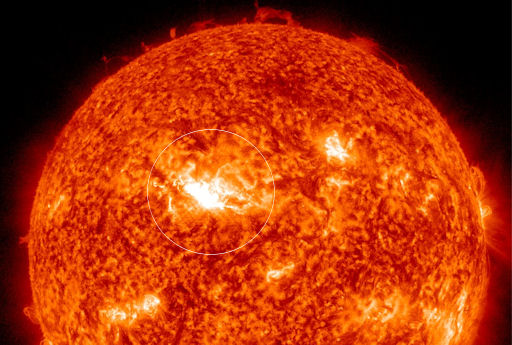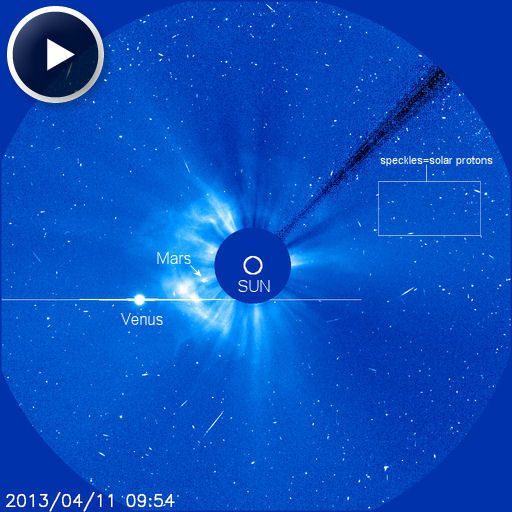MINOR RADIATION STORM: Energetic solar protons are flying past Earth today. The particles were accelerated in our direction by the M6-class flare of April 11th (see below). They can be seen hitting and speckling the detector of the SOHO spacecraft in this movie of the explosion (labeled image). NOAA ranks the ongoing radiation storm as S1, which is considered a minor event. Solar flare alerts: text, voice.
STRONG SOLAR FLARE: The magnetic field of sunspot AR1719 erupted on April 11th at 0716 UT, producing an M6-class solar flare. NASA's Solar Dynamics Observatory recorded the explosion's extreme ultraviolet flash:
Coronagraph images from the Solar and Heliospheric Observatory (SOHO) show a CME emerging from the blast site. The expanding cloud should hit Earth's magnetic field during the early hours of April 13th, possibly sparking geomagnetic storms and auroras. Aurora alerts: text, voice.
Click to play a movie of the CME recorded by (SOHO):
The speckles near the end of the movie are caused by energetic solar protons hitting the coronagraph's CCD detector; the particles were accelerated in the direction of the spacecraft by the flare.
Note that although the CME appears to hit Mars and Venus, there is no actual physical contact. The cloud is merely passing in front of the two planets. Stay tuned for updates about this significant explosion.

![]()
Solar wind
speed: 456.8 km/sec
density: 1.2 protons/cm3
explanation | more data
Updated: Today at 2207 UT
![]()
X-ray Solar Flares
6-hr max: C1 2153 UT Apr11
24-hr: M6 0716 UT Apr11
explanation | more data
Updated: Today at: 2200 UT
![]()
![]()
![]()
Daily Sun: 11 Apr 13
![]()
![]()
Sunspots AR1718 and AR1719 pose a threat for M-class solar flares. Credit: SDO/HMI
![]()
![]()
![]()
Sunspot number: 163
What is the sunspot number?
Updated 11 Apr 2013
Spotless Days
Current Stretch: 0 days
2013 total: 0 days (0%)
2012 total: 0 days (0%)
2011 total: 2 days (<1%)
2010 total: 51 days (14%)
2009 total: 260 days (71%)
Since 2004: 821 days
Typical Solar Min: 486 days
Update 11 Apr 2013
The Radio Sun
10.7 cm flux: 148 sfu
explanation | more data
Updated 11 Apr 2013
![]()
![]()
![]()
Current Auroral Oval:
![]()
Switch to: Europe, USA, New Zealand, Antarctica
Credit: NOAA/POES
![]()
![]()
![]()
Planetary K-index
Now: Kp= 1 quiet
24-hr max: Kp= 2 quiet
explanation | more data
![]()
Interplanetary Mag. Field
Btotal: 4.8 nT
Bz: 2 nT south
explanation | more data
Updated: Today at 2207 UT
![]()
![]()
![]()
Coronal Holes: 11 Apr 13
![]()
![]()
There are no large coronal holes on the Earthside of the sun. Credit: SDO/AIA.






